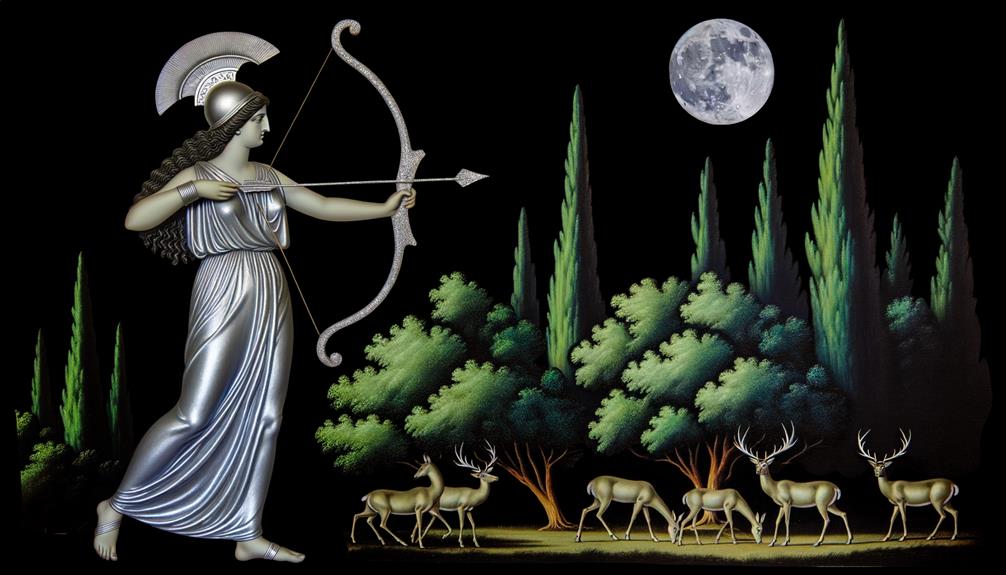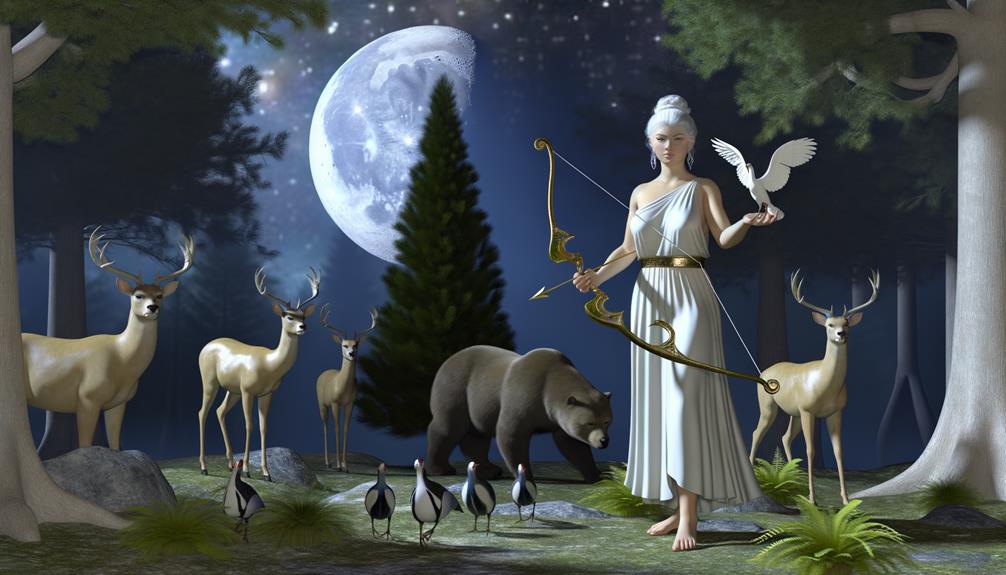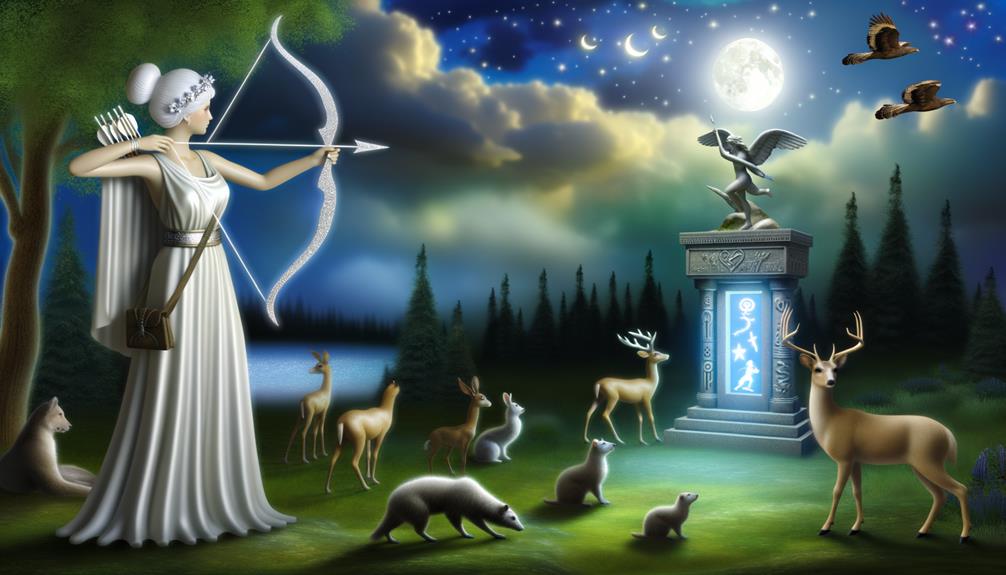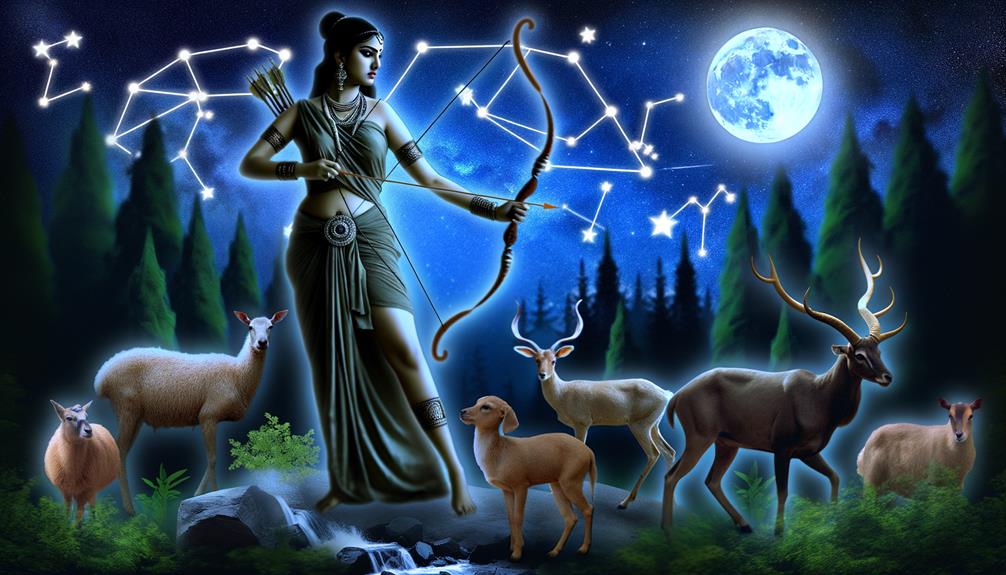You reckon your family reunions are crammed with drama? Then you must not be familiar with the Greek gods, particularly Artemis, the Huntress Goddess.
Artemis is a multifaceted character, her story is packed with elements of wilderness, motherhood, and chastity, making her one of the most compelling figures in Greek mythology. As the twin sister of Apollo and the offspring of Zeus and Leto, she is no stranger to intense drama and legendary stories. However, her character goes beyond family connections and clashes among the gods.
Armed with her silver bow and accompanied by her group of nymph friends, Artemis symbolizes raw, untamed independence. She is a guardian of the young and a bringer of sudden death and disease. You wouldn't want to mess with this goddess, and as we delve into her story, you'll realize that there's a lot more to her than just her hunting skills.
So, are you set for an exciting journey through the wilderness of Artemis's lore?
The Origins of Artemis

Let's talk about Artemis, whose name is steeped in intrigue. Scholars are still arguing over its origins, with some believing it comes from pre-Greek times, while others think it's from Phrygia. The first reference to Artemis in ancient Greek literature was by Hesiod. She's famed as a hunting goddess and held in high regard in the ancient world. Artemis is the child of Zeus, the leader of the Greek gods, and Leto, a Titaness.
Artemis is often shown with her bow, signifying her multifaceted character and the various roles she plays in Greek life and culture. She's the goddess of purity and virginity, seen as a guardian of young women and girls. Her symbols, which include hunting spears and sacred animals such as the deer, boar, and bear, highlight her connection to nature and hunting.
Artemis shares many characteristics with the Mycenaean goddess of nature, reflecting elements of the Minoan form. She's linked to marriage, childbirth, and is known to have a vengeful streak, showcasing her complex personality. The extensive worship of Artemis in Greece, especially in Arcadia, demonstrates her lasting impact and importance in Greek mythology.
Artemis: Spheres of Influence

Let's chat about Artemis, the Greek goddess, and the many roles she played in the ancient world. Known for her diverse qualities, she held sway in many different areas, reflecting her significance in Greek mythology.
- Hunting Goddess: Artemis was a boss when it came to wildlife. With her divine arrows, she played a key role in managing and protecting animals. This earned her the title of the hunting goddess.
- Artemis and Apollo: Artemis shared a special bond with her twin brother, Apollo. Born to Leto, they were often worshipped together, both having a say over health and disease.
- Symbol of Chastity and Virginity: Artemis was a virgin goddess, known for her purity. She also looked out for young girls, keeping them safe and secure.
- Artemis Orthia: In this form, Artemis was seen as the embodiment of the harsh and brutal side of nature. People worshipped her for the power she held to both cause and prevent revenge.
- Moon Goddess: She was also linked to the moon, offering a neat balance to Apollo's ties with the sun.
Artemis was held in high regard, and her worship was widespread. Her control over different aspects of life and nature intertwined, making her a complex and intriguing character. From hunting to chastity, and from the wilderness to the moon, the influence of Artemis was diverse, mirroring her status as a powerful and respected deity.
Sacred Symbols and Animals

Artemis, often portrayed as a hunter, is deeply intertwined with various sacred symbols and animals, each one standing for different facets of her power and influence in Greek mythology. Seeing her as the goddess of the hunt, Artemis' symbols are purposeful and demonstrate her skills. Her bow and arrows, which are her main symbols, highlight her deadly precision. The hunting quiver she's often depicted with shows her preparedness for the hunt.
The animals sacred to Artemis further demonstrate her control over the wild. The deer, often shown being hunted by her, is the most important among these animals. Wild animals like boars and bears are also revered, symbolizing her strength and fierceness. Intriguingly, Artemis was known to turn people into animals as a form of punishment, showcasing her vengeful side.
Artemis, known as the 'Mistress of Animals', is closely tied to wild animals and hunting dogs, emphasizing her control over nature and wilderness. Her role as the animals' protector, especially during hunts, brings out a contradictory side of her – she hunts, but she also preserves, ensuring that nature's delicate balance is maintained.
Artemis: Acts of Vengeance
Artemis, known for her connection with animals and hunting, demonstrates her power over nature. She carries a strong message in Greek myths with her name, showing the depth of her role as a protector of sacred chastity and honor. Let's take a look at a few examples:
- Artemis transformed Actaeon into a stag because he saw her bathing, though unintentionally.
- She also changed Callisto into a bear, as she broke her vow of chastity.
- Artemis didn't spare Niobe when she arrogantly boasted, and killed her children as a form of revenge.
- Art and literature in Greece often portray these acts of vengeance by Artemis.
Artemis was known to be highly protective of sacred chastity and honor. In the pantheon of Greek gods, Artemis, the goddess of the moon, was both respected and feared for her swift and harsh justice. The Temple of Artemis, which is one of the Seven Wonders of the Ancient World, stands as a monument to her divine power and influence.
Her acts of vengeance are crucial in understanding Artemis' character and the values she stood for in Greek mythology. This aspect of Artemis, which originates from her childhood, sets her apart from other divine figures in Greek mythology.
Worship and Depictions of Artemis

Let's talk about Artemis, a key figure in Greek mythology. She's not just any goddess, but a multi-dimensional one with a huge following and countless interpretations.
Artemis, born to the goddess Leto, is known as the protector of young ones, a role she shares with her twin brother, Apollo. This part of her identity was greatly admired in the ancient Greek faith, leading to several sacred practices devoted to her.
Now, when you think of Artemis, you might picture her as a huntress, similar to the famed Greek figure Atalanta. Why's that, you ask? Well, she's often shown carrying a bow and arrow, which speaks volumes about her command over nature and her mission to keep everything in nature running smoothly. This image of Artemis, coupled with her role as a protector, is drawn in a variety of ways, each presenting a unique part of her layered personality.
One depiction that's really intriguing is the Brauronian Artemis, where she's portrayed as a bear. This shows her power and control over animals. The inspiration for this comes from the Homeric Hymn to Artemis, a valuable source of information about how people worshipped her.
From being the goddess of childbirth to a huntress, the many faces of Artemis underline her significance in Greek mythology.
Frequently Asked Questions
What Is the Story of the Goddess Artemis?
Let's chat about a really engaging character from mythology – Artemis. You might know her as the daughter of Zeus and Leto, or perhaps as Apollo's twin. She's a master when it comes to hunting and she's got a big soft spot for young girls, often acting as their guardian. Her choice to remain a virgin isn't about purity, it's about her being fiercely independent. And, interestingly, she's often linked with two diverse elements – the moon and the wilderness.
Did Artemis Have Huntresses?
Absolutely, Artemis had a group of huntresses. These were typically young women, adept at both archery and hunting. They held the same beliefs as Artemis, cherishing their purity and self-reliance. Acting as her close friends, they embodied the spirit of the wilderness and were guardians to young girls.
Who Is the Huntress Goddess in Greek Mythology?
Let's chat about the venerated huntress goddess in Greek mythology, her name is Artemis. Isn't it interesting how she embodies elements of the wild, like hunting, and simultaneously symbolizes childbirth? You will often see her in art, armed with a bow and arrows. What's more, her sacred symbols are as wild as her domain – they include the deer, boar, and bear. It's fascinating, isn't it?
Who Did Artemis Turn Into a Girl?
To my knowledge, there's no myth that tells a tale of Artemis transforming a person into a girl. It's documented that she had the power to morph people into animals – take for instance, how she changed Callisto into a bear. However, there's no record of her altering someone's gender in her stories.
Conclusion
If you think about it, Artemis, known as the Huntress Goddess, truly represents the wild soul of ancient Greece. She stands as a symbol of intense self-reliance, safeguarding those who can't defend themselves, and serving justice.
Her story, rich with themes of revenge and healing, speaks volumes about her contrasting qualities. She's both the unfettered wilderness and the caring mother figure, a reflection of the conflicting aspects we all have within us.
So, when we step into the unknown territories of our lives, let's remember to carry the resolve and kindness of Artemis in our hearts.

